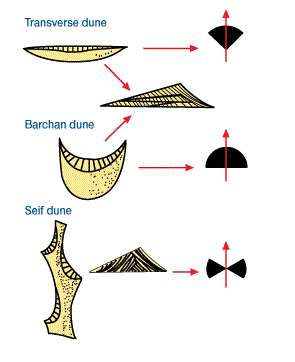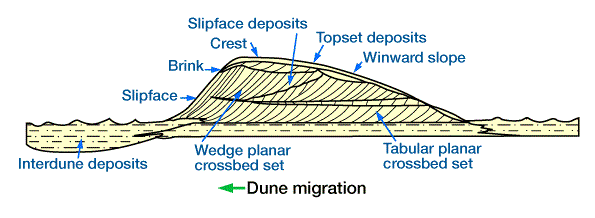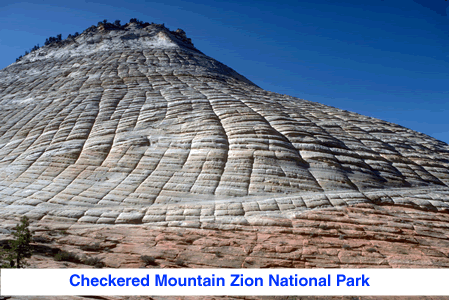Depositional Processes and Lithologic Characteristics Eolian Environments
Formation of Eolian Deposits
Eolian deposits are primarily formed through the process of erosion, transport, and deposition. The cycle begins when the wind erodes loose particles from the source area, such as deserts or sandy plains. These particles, mainly consisting of sand-sized grains, are then transported by wind currents over long distances. During transportation, the grains may collide, resulting in rounding and sorting based on size.
When the wind loses energy, it can no longer sustain the transport of the sand particles. This leads to the deposition of sediments in the form of sand dunes or other eolian landforms. The process is cyclic, with continuous erosion and deposition shaping the eolian environment over time.
Figure 1 (Relationships between dune morphology and the orientation of cross-bedding. Far right diagrams show azimuth frequency).

illustrates the four most common modern dune forms. Discerning specific dune types in the subsurface is only rarely important to the petroleum geologist. More often, simply deciding whether a facies is actually eolian or not consumes the major effort; however, a basic understanding of the different types does provide information essential to the knowledge of what reservoir characteristics can normally be expected.
Barchans and transverse dunes today are transient, unstabilized features that migrate continuously downwind. Despite this, the crossbed pattern they produce appears typical for the majority of dune complexes preserved in the sedimentary record. (Figure 2, Cross section of a barchan or transverse dune showing the various bedforms and slipface surfaces).

In contrast, stellate (spider-shaped) and seif (knife-edge or longitudinal) dunes, with their more complex stratification patterns, are permanent features today in the great Saharan, Mongolian, Australian, and Arabian sand seas, but have not often been identified in lithified formations.
The usual vertical sequence of textures and sedimentary structures seen in most dunes is shown in Figure 2. The common subfacies of the interdune area include:
clay and silt (ephemeral lakes)
evaporites(salt/gypsum lenses from lake evaporation)
sand and gravel (as “deflation” lag after the wind has removed smaller detritus)
Crossbed foresets (both tabular and trough types) are often larger (20 ft to 100 ft), steeper (20° to 35°), and more concave-upward, than in aqueous sands.
Medium-to giant-scale, cross-stratified dune units are commonly truncated — with the low-angle toeset beds of the overlying unit cutting off the high angle foreset beds of the underlying unit — and stacked. Such multiple-stacked complexes make up the greater part of eolian formations. (Figure 3, Photo of giant scale cross-bedding in the Navajo Sandstone of southern Utah)

Sand grains can show a range of size and rounding, as well as certain surface characteristics, such as frosting and pitting. The high degree of rounding found in those sands composing the great ergs (“seas”) of north Africa and Arabia is primarily the result of repeated reworking, i.e., several generations of erosion and redeposition. In contrast, grains composing the landforms at Great Sand Dunes National Monument in Colorado, show diversity of specific sedimentologic traits, including both high-angularity and compositional heterogeneity.
Wind is generally an excellent sifting agent. Though grain size will vary according to position on a dune, the sorting within each size range is usually good to excellent. Grain orientation can occur within single crossbed layers, and this can impose a certain amount of directional permeability to the rock. This will be discussed below in more detail, as it can be an important reservoir characteristic.
Some dunes, particularly along coast lines, are composed of marine skeletal carbonate sands. These, however, are rare in the subsurface. Quartz sand dunes also form on barrier islands and spits, and may thus be incorporated as local subfacies within otherwise transitional or marine facies.
Like other subaerial sands, eolian complexes have played host to the postburial percolation of acidic meteoric waters, which have sometimes imparted reddish coloration. Clean, white sequences, however, are equally common.
 Petro Shine The Place for Oil and Gas Professionals.
Petro Shine The Place for Oil and Gas Professionals.



